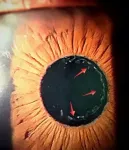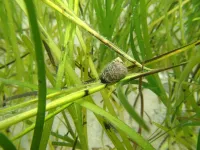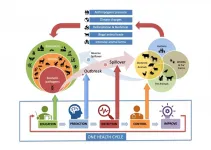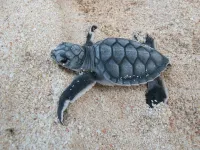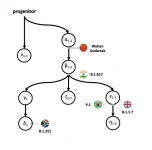(Press-News.org) SINGAPORE - A team of researchers from the Agency for Science, Technology and Research's (A*STAR) Genome Institute of Singapore (GIS) and Bioprocessing Technology Institute (BTI), as well as Singapore Eye Research Institute (SERI), have identified a genetic mutation (functionally defective CYP39A1 gene) associated with exfoliation syndrome, the most common cause of glaucoma. The findings could pave the way for future research on the cause of exfoliation syndrome and potential cures. Their research was published in Journal of the American Medical Association (JAMA) on 24 February 2021.
Exfoliation syndrome is a systemic disorder characterised by abnormal protein material that progressively accumulates in the front of the eye. This disorder is the most common cause of glaucoma, and a major cause of irreversible blindness.
In this study, the scientists sequenced all protein encoding genes of more than 20,000 participants from 14 countries across Asia, Europe, and Africa, including more than 1,200 Singaporeans. They observed that people with exfoliation syndrome are twice as likely to carry damaging mutations in the gene encoding for the CYP39A1 protein, an enzyme which plays an important role in the processing of cholesterol. Further extended analyses suggest that defective CYP39A1 function is strongly associated with increased risk of exfoliation syndrome.
Although exfoliation syndrome is the most common cause of glaucoma, its origin is shrouded in mystery because it is not known where the abnormal protein deposits (exfoliative material) originate, and how the disease comes about. Answers to these questions could provide approaches to design and develop an effective treatment. The current findings point to the important role of cholesterol processing in the exfoliation syndrome disease process. As cholesterol is found abundantly in all cells, disruption to how cholesterol is processed due to defective CYP39A1 activity could adversely impact their normal functions. In particular, this study discovered that epithelial cells in the front of the eye responsible for filtering the blood supply to produce the clear fluid known as aqueous humour that bathes and nourishes other cells in the eye, were most affected by the CYP39A1 gene mutation. Disruption to the gene function can compromise the filtering function of epithelial cells and lead to leakage of exfoliative material from the blood into the eye.
Prof Patrick Tan, Executive Director of GIS, said, "This is a ground-breaking study that could facilitate future research efforts aimed at restoring defective CYP39A1 function and inhibiting the formation of exfoliation material in the eye as treatments for exfoliation syndrome and glaucoma."
Prof Aung Tin, Director of SERI and Deputy Medical Director of SNEC, said, "This is a major eye disease, affecting over 70 million people worldwide, which causes a lot of visual morbidity and blindness, not only from glaucoma but also due to complications related to cataract surgery. This study was notable for involving many centres from many different countries around the world, but led from Singapore. The study findings are very exciting as we found a new pathway for the disease which opens up possibilities for new treatments."
Prof David Friedman, the Albert and Diane Kaneb Chair in Ophthalmology at Harvard University and Director of the Glaucoma Service at the Massachusetts Eye and Ear Infirmary, Boston, commented, "Very exciting work. The researchers have identified rare gene variants that results in disrupted cholesterol homeostasis and transport that will open the door to novel therapeutics. Having studied over 20,000 individuals, the study demonstrates the power of studying rare variants to detect disease-causing genes in complex conditions." Prof Friedman was not involved in the study.
INFORMATION:
About A*STAR's Genome Institute of Singapore (GIS)
The Genome Institute of Singapore (GIS) is an institute of the Agency for Science, Technology and Research (A*STAR). It has a global vision that seeks to use genomic sciences to achieve extraordinary improvements in human health and public prosperity. Established in 2000 as a centre for genomic discovery, the GIS pursues the integration of technology, genetics and biology towards academic, economic and societal impact, with a mission to "read, reveal and write DNA for a better Singapore and world".
Key research areas at the GIS include Precision Medicine & Population Genomics, Genome Informatics, Spatial & Single Cell Systems, Epigenetic & Epitranscriptomic Regulation, Genome Architecture & Design, and Sequencing Platforms. The genomics infrastructure at the GIS is also utilised to train new scientific talent, to function as a bridge for academic and industrial research, and to explore scientific questions of high impact.
For more information about GIS, please visit http://www.a-star.edu.sg/gis.
About the Agency for Science, Technology and Research (A*STAR)
The Agency for Science, Technology and Research (A*STAR) is Singapore's lead public sector agency that spearheads economic oriented research to advance scientific discovery and develop innovative technology. Through open innovation, we collaborate with our partners in both the public and private sectors to benefit society.
As a Science and Technology Organisation, A*STAR bridges the gap between academia and industry. Our research creates economic growth and jobs for Singapore, and enhances lives by contributing to societal benefits such as improving outcomes in healthcare, urban living, and sustainability.
We play a key role in nurturing and developing a diversity of talent and leaders in our Agency and research entities, the wider research community and industry. A*STAR's R&D activities span biomedical sciences and physical sciences and engineering, with research entities primarily located in Biopolis and Fusionopolis.
For ongoing news, visit http://www.a-star.edu.sg.
About Singapore Eye Research Institute (SERI)
SERI is Singapore's national research institute for ophthalmic and vision research. SERI has grown from a founding team of five in 1997 to a faculty of more than 250 staff, encompassing clinician scientists, scientists, research fellows, PhD students and support staff. SERI has also over 240 adjunct faculties from various eye departments, biomedical institutes and tertiary centres in Singapore. This makes SERI one of the largest research institutes in Singapore, as well as the largest eye research institute in the Asia Pacific region.
SERI's mission is to conduct high-impact eye research that prevents blindness, low vision and major eye diseases common to Singaporeans and Asians. Over the last decade, SERI has conducted landmark research projects that have led to tangible outcomes, patient benefits, and success stories. It has paved the way for significant improvements in how eye diseases are treated and prevented, not just for Singaporeans or Asians, but on a global scale.
For more information about SERI, please visit http://www.seri.com.sg
Artificial intelligence that enhances remote monitoring of water bodies - highlighting quality shifts due to climate change or pollution - has been developed by researchers at the University of Stirling.
A new algorithm - known as the 'meta-learning' method - analyses data directly from satellite sensors, making it easier for coastal zone, environmental and industry managers to monitor issues such as harmful algal blooms (HABs) and possible toxicity in shellfish and finfish.
Environmental protection agencies and industry bodies currently monitor the 'trophic state' of water - its biological productivity - as an indicator of ecosystem health. Large clusters of microscopic algae, or phytoplankton, is called eutrophication and can ...
Mangroves and seagrasses grow in many places along the coasts of the world, and these 'blue forests' constitute an important environment for a large number of animals. Here, juvenile fish can hide until they are big enough to take care of themselves; crabs and mussels live on the bottom; and birds come to feed on the plants.
However, the plant-covered coastal zones do not only attract animals but also microplastics, a new study shows.
- The denser the vegetation, the more plastic is captured, says Professor and expert in coastal ecology, Marianne Holmer, from the University of Southern Denmark.
She is concerned about how the accumulated microplastics affect animal and plant life.
- We know from other ...
The EU-funded BIO-CRIME project - with support from the Leibniz Institute for Zoo and Wildlife Research (Leibniz-IZW) - conducted a scientific investigation on the topic of illegal small animal trade and the associated risk of pathogen transmission.
The study focused on the key areas of "illegal small animal trade" and the level of knowledge and proper behaviours of young people and adolescents with "zoonotic diseases" and the "One Health concept". One Health is an approach that recognises that human health is closely linked to the health of animals and our shared ...
In 2019 the climate movement experienced an unprecedented growth in its mobilization capacity and its political and media impact. The success of the movement is closely linked to the figure of Greta Thunberg and the global impact of her discourse and the "Fridays for Future" movement in hundreds of cities around the world.
A study by Silvia Díaz-Pérez, Roger Soler-i-Martí and Mariona Ferrer-Fons, members of the UPF JOVIS research group of the Department of Communication, analyses the activist's speeches and messages on social networks and their legitimization through her personal story, and it also looks into the "Fridays for Future" movement in Barcelona, based on Twitter and Instagram posts. The research was based on a project that has received funding from ...
Cryptocurrencies like Bitcoin are becoming increasingly popular. At first glance, they have many advantages: Transactions are usually anonymous, fast and inexpensive. But sometimes there are problems with them. In certain situations, fraud is possible, users can discover information about other users that should be kept secret, and sometimes delays occur.
The research unit "Security and Privacy" at TU Wien (Lukas Aumayr and his supervisor Prof. Matteo Maffei) in collaboration with the IMDEA Software Institute (Prof. Pedro Moreno-Sanchez, previously postdoc at TU Wien) and the Purdue University (Prof. Aniket Kate) analyzed these problems and developed an improved protocol. It has now been published and will be presented this year at ...
Sea turtles in the Cayman Islands are recovering from the brink of local extinction, new research shows.
Monitoring from 1998-2019 shows loggerhead and green turtle nest numbers increased dramatically, though hawksbill turtle nest numbers remain low.
In the first counts in 1998-99, just 39 sea turtle nests were found in total on the three islands. By 2019, the figure was 675.
Captive breeding of green turtles and inactivity of a traditional turtle fishery due to tightening of restrictions in 2008 contributed to this - but populations remain far below historical levels and still face threats including ...
In the field of molecular epidemiology, the worldwide scientific community has been steadily sleuthing to solve the riddle of the early history of SARS-CoV-2. Despite recent efforts by the World Health Organization, no one to date has identified the first case of human transmission, or "patient zero" in the COVID-19 pandemic.
Finding the earliest possible case is needed to better understand how the virus may have jumped from its animal host first to infect humans as well as the history of how the SARS-CoV-2 viral genome has mutated over time and spread globally.
Since the first SARS-CoV-2 virus infection was detected in December 2019, well over a million genomes of SARS-CoV-2 have been sequenced worldwide, ...
May 04, 2021 - In its latest clinical practice guideline on community-acquired pneumonia the American Thoracic Society's guidelines panel addresses the use of nucleic acid-based testing for non-influenza viral pathogens. The guideline was published online in the May 1 issue of the American Journal of Respiratory and Critical Care Medicine. An explainer video may be viewed here.
Community-acquired pneumonia is caused by a wide range of respiratory pathogens, prominently including viruses. However, the only viral pathogen addressed by the 2019 clinical practice guideline was influenza. The panel determined that, given the increasing recognition of non-influenza viral causes ...
DAVIS, CA, May 4, 2021 - In a randomized, controlled study* published online in the journal, Nutrients, researchers found that including mixed tree nuts in a weight management program resulted in significant weight loss and improved satiety.
Researchers at UCLA compared 95 overweight/obese men and women (BMI 27.0-35.0 kg/m2) ages 30-68 years who consumed either 1.5 ounces of mixed tree nuts or a pretzel snack. Both snacks provided the same number of calories, as part of a hypocaloric weight loss diet (500 calories less than resting metabolic rate) over 12 weeks. This was followed by an isocaloric weight maintenance program for an additional ...
Cancer of the colon and rectum is one of the deadliest forms of cancer, and has in recent years affected growing numbers of young people. In the largest registry study to date, researchers at Karolinska Institutet in Sweden and Harvard University in the USA demonstrate a possible connection between colorectal polyps in close relatives and the risk of developing colorectal cancer. The study, which is published in the British Medical Journal, is of potential consequence for different countries' screening procedures.
Colorectal cancer is the second deadliest form of cancer in the world, according to the World Health ...
